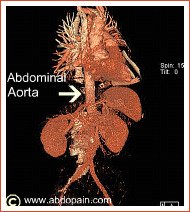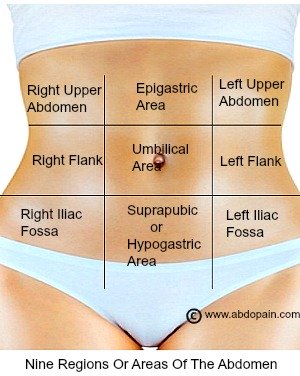Areas of the abdomen
Understanding The Various Areas Of The Abdomen In Medical Terms, The Organs And Associated Diseases And Conditions Common To Each Area.
These are the 9 areas of the abdomen in medical terms and
what they contain as well as the common causes of pain or illness in each of
these areas or regions of the tummy. You would be use more precise medical terms when describing where your abdominal pain is located.
The human abdomen has been divided into 9 arbitrary regions or areas for ease of description of an area of pain, swelling, injury or incision.
Each of these regions contains a number of organs.
Injury, infection or any other type of disease affecting any of the organ domiciled in an area of the abdomen could cause pain in that vicinity.
A clear understanding of the anatomical boundaries and descriptions of these regions of the abdomen would be helpful in providing a uniform term when such pert of the abdomen is been referred to. It may also help you in being able to communicate more specifically with your healthcare provider when describing you abdominal pain.
Before listing the various areas of the abdomen and the organs found in each, it is important to mention quickly that an organ found in one area of the abdomen could overlap into one or more other areas. An example is the liver, the single largest organ in the body apart from the skin, spreads across three regions of areas of the abdomen.
The nine areas of the human abdomen are:
- Right Upper Quadrant (Right Hypochondrium)
- Epigastric region (Epigastrium)
- Left Upper Quadrant (Left Hypochondrium)
- Right Flank (Right Lumbar region)
- Para-umbilical region
- Left Flank (Left Lumbar region)
- Right Iliac fossa
- Suprapubic (Infra-umbilical or Hypogastric region)
- Left iliac fossa.
These Areas of the abdomen have been carved out by drawing straight imaginary lines across the surface of the abdomen – two vertical and two horizontally, cutting the topography of the abdomen into nine parts.
They are:
- One on the right and one the left, vertically downwards from the center of the collar bones, passing through the nipple on each side southwards to the mid-point of the upper thighs
- An horizontal line cutting across from right to left on the upper abdomen, drawn at the level of the lower border of the rib cage – that is, a straight line drawn at the level of the lowest bony structure one side of the rib cage to the other side
- The second horizontal line is draw at the level of the top pelvic bone one on side straight to that on the other side.
The upper horizontal line is sometimes drawn at a slightly different levels by some doctors, at the level of the midpoint between the tip of the pubic bone in the middle and the mid-line notch at the top of the sternum.
You can see these areas well represented on the picture of the areas of the abdomen on this page.
The Four Quadrants of The Abdomen
It is important to mention that sometimes, these arbitrary nine areas of the abdomen, rather than help in enhancing the description of the abdomen, could in fact be a clog and make descriptions clunky.
Some medical authorities instead, prefer to keep thing simple and divide the abdomen into four regions or true quadrants.
They are:
- The right Upper Quadrant
- The left upper Quadrant
- The Right Lower Quadrant and the
- Left lower Quadrants.
These true quadrants of the abdomen are derived by drawing an imaginary vertical line through the surface of the middle of the abdomen, passing from the lower end of the sternum down through the navel or umbilicus to the top of the middle of the pubis.
Another imaginary line, this time horizontal, is drawn from one side of the abdomen to the other side, at the level of the navel of umbilicus.
Which of these descriptions do
you find more useful: that of the 9 areas or the 4 quadrants? And why?
We would really love to hear your views on the comment box below.
Referred Pain Away From The Areas of The Abdomen

Injury or diseases affecting organs in some of these arbitrary regions of the abdomen could also cause pain in other areas of the body far away from where the diseased organ is.
Such pain caused by injury or disease in one area of the body but felt in another part of the body is called "referred pain".
Common examples of referred pain from abdominal injury or disease process are:
- Right Shoulder tip pain which could result from bowel or stomach perforation or indeed rupture of the liver. This could also result from ectopic pregnancy or any cause of bleeding into the abdominal cavity, causing blood to be indirect contact with and thus irritation of the diaphragm
- Left Shoulder tip pain – this could result from bowel or stomach perforation, rupture of the spleen, or any cause of bleeding into the abdominal cavity, like ectopic pregnancy, causing blood to be in direct contact with the under surface of the diaphragm as described above
- Upper Back pain Between the Shoulder Blades or Scapular Bones. This could result from peptic ulcer disease, gallbladder stone, pancreatitis or rupture or leak of an abdominal aortic aneurysm (the last condition is very uncommon before age 65 and not likely in anyone who had never smoked)
- Pain in the abdomen and tip of the Penis. This is usually from kidney stone or ureteric colic – stone in the ureter.
Referred Pain To The Abdomen Regions
Just as pain could be referred away from the regions of the abdomen from diseases affecting organs in the abdomen, so sometimes, pain can be referred to the regions of the abdomen from disease condition snot emanating from the abdomen.
Examples of such are:
- Pain in the Epigastrium From heart attack. Yes. A heart attack pain can, in some cases start from the epigastrium. This is because the diaphragm and covering of the heart have the same nerve root. Pain arising from the heart could show as pain in the epigastric region. If you are more than forty, have diabetes or hypertension or family history of heart attack (in your parents or siblings), and if you experience a dull heavy ache in your epigastrium with associated nausea, shortness of breath or unusual cold sweats lasting for more than 15 minutes (even if it goes off and comes back, then you must seek medical attention as soon as possible to exclude a possible heart attack.
- Slipped Thoracic Disc. Pain from a slipped disc in your upper back could be “referred” or spread to your right or left upper quadrant or flank, depending on which nerve root is compressed.
- Herpes Zoster or Shingles. Herpes zoster affecting a nerve root in the middle or lower thorax could cause pain spreading to the flanks or indeed any part of the abdomen. Usually there would be an accompanying rash on your back or flank.
Let us now take a look at each of these areas or regions of the abdomen, the organs found there and common causes of pain in each of them.
Reference:
- Last's Anatomy. Regional And Applied. 10th Edition. Chummy S. Sinnatamby FRCS. Published by Churchill Livingstone. 1999. Reprinted 2001. Page 215.
Published on the 31st of October 2015 by Abdopain.com Editorial Team under Areas of the Abdomen.
Article was last reviewed on 1st November 2015.




